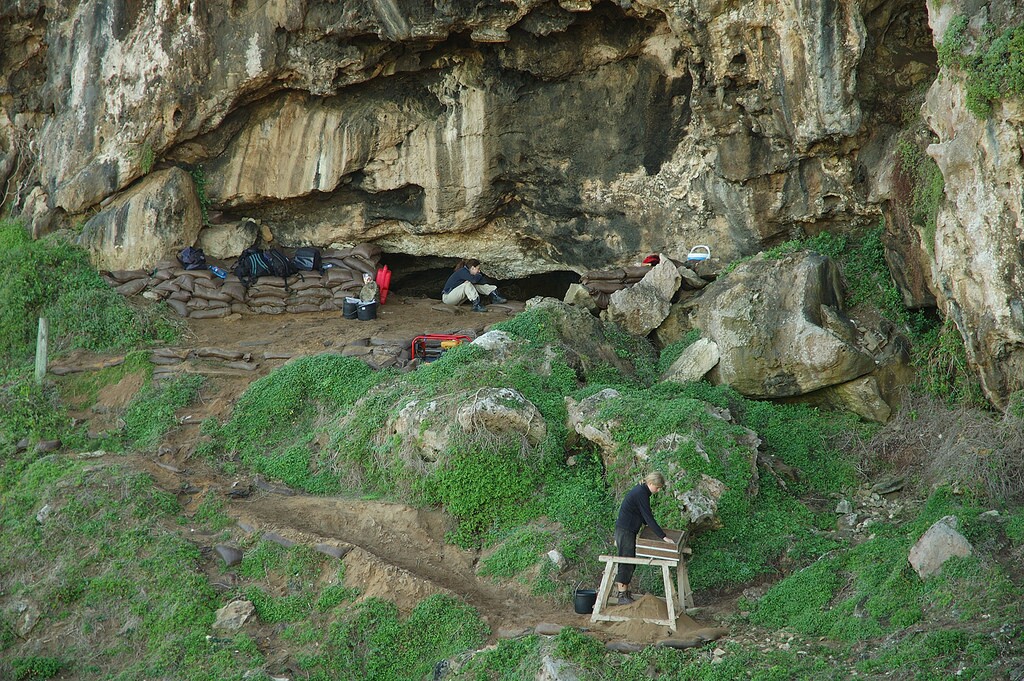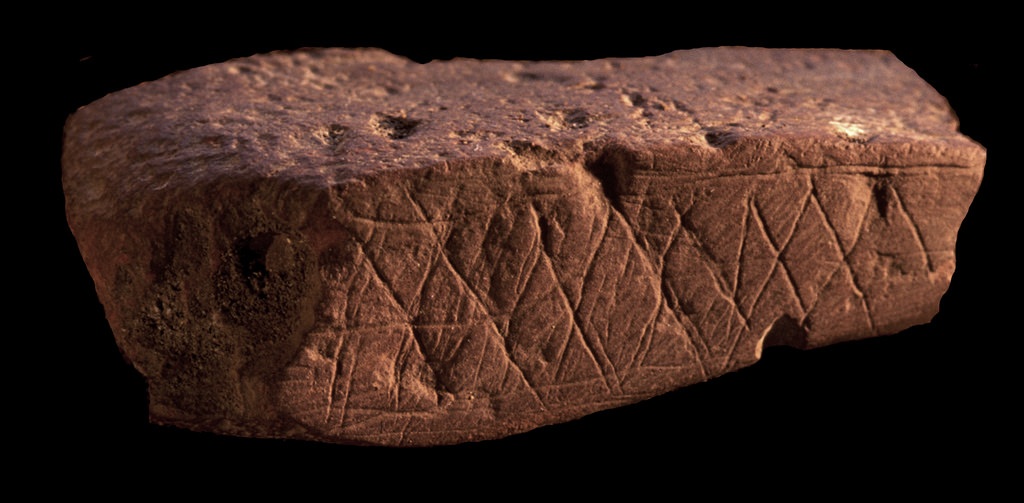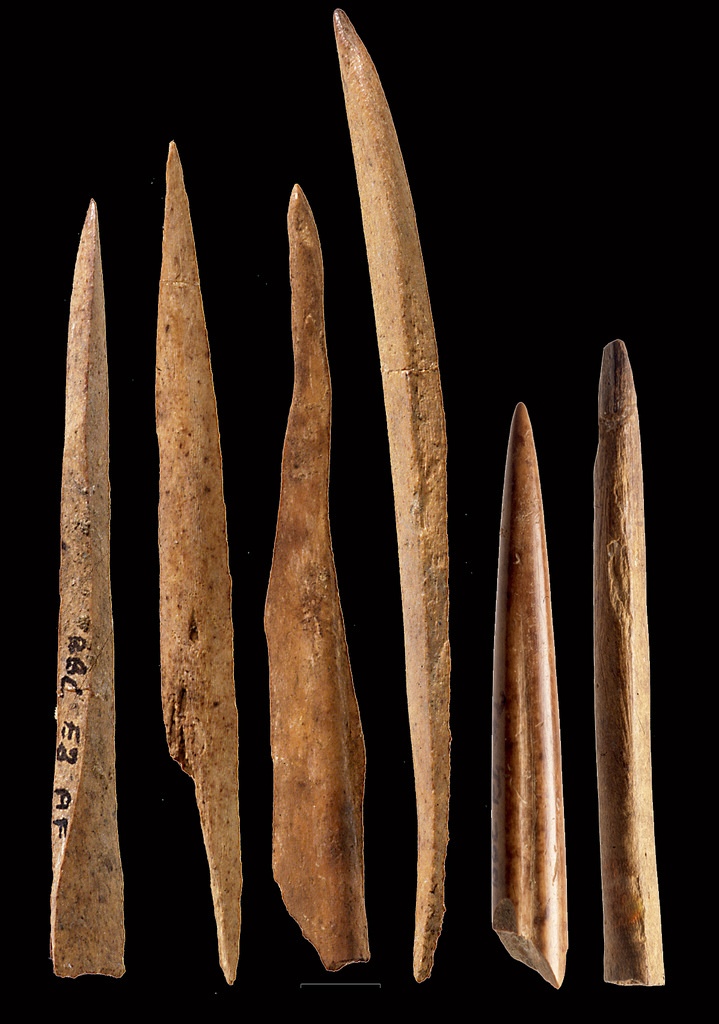
Decades of research and discovery have generated new revelations and theories about the ascent of our species, Homo sapiens, within the context of biological evolution. Consensus to date suggests that human origins took place in Africa, as evidenced through the archaeological and paleontological record, including new discoveries in human genetics. But the ongoing search for the detailed specifics of human origins has raised, as scientific inquiry often does, more questions than answers. Among the mysteries of the ongoing search are the questions revolving around where, when, and how anatomically modern humans became humans capable of the advanced cognition and behavior necessary for the foundation of modern culture and civilization. Recent years have seen some remarkable new discoveries being made in South Africa that are shedding light on these questions.
Popular Archaeology interviewed Dr. Christopher Henshilwood, Professor of Middle and Later Stone Age African Archaeology at the University of Bergen. He is also a key member of the Evolutionary Studies Institute at the University of Witwatersrand, and he is arguably the world’s leading researcher and authority on the emergence of modern human behavior and cognition, especially as it is reflected in the archaeological record. Geographically, his work has focused primarily on certain sites along the coast of South Africa that have revealed some intriguing clues in recent years bearing on the search for modern human origins. What follows is his response to a series of questions posed to him about the latest discoveries:
______________________________________
What, from your perspective, is the significance of the research you have been conducting as it relates to behaviorally modern humans? And how do you define ‘behaviorally modern’?
Not long ago, most people didn’t think that humans living around 100,000 years ago had enhanced cognitive abilities – abilities that allowed for complex behaviors, such as long-range planning, the use of symbols and complex language. It was thought that human culture, often implied by art, such as jewelry and engraved designs, suddenly appeared during the Upper Palaeolithic in Europe 40,000–50,000 years ago.
Evidence of symbolic thought (the transmission of coded information) and long range planning mark milestones in the evolution of Homo sapiens. The creation of paint, collection and manipulation of unique raw materials, and physical ornamentation are just some evidence that humans living ~100,000 years ago could conceptualize, create and store items for future use. It is these kinds of actions that are unique to modern humans and indicate that they were behaviorally modern, had enhanced cognitive abilities and social conventions and identities similar to humans living today.
My research into the MSA (Middle Stone Age), along with the finds of many other MSA researchers, has produced crucial evidence that modern human behavior originated in southern Africa; the origins were not in Europe.
What have been your research objectives related to this topic?
My research focus has been the MSA along the southern Cape coast of South Africa. My research has looked at the early behavioral evolution of Homo sapiens, the origins of language and symbolic behavior, and the effects of climate and climate change on human demographics.
What have been the important sites for your field work, and why?
My fieldwork has been focused on two sites along the southern Cape coast of South Africa – Blombos Cave and Klipdrift Complex. We have excavated at Blombos Cave from 1992. The results of these excavations and our discoveries at the site are published in numerous papers and books, and analysis of the remarkable material culture is ongoing. The MSA levels at Blombos Cave are dated to between 130,000 – 72,000 years ago (dated using optically stimulated luminescence, OSL) and the lithic component at the site relates to Still Bay and pre-Still Bay techno-complexes.
The other site is Klipdrift Shelter. This is part of the Klipdrift Complex, which is located in the De Hoop Nature Reserve. The MSA levels at Klipdrift Shelter are dated to 66,000 – 52,000 years ago (dated using OSL), and the lithic component relates to the Howiesons Poort techno-complex. We have made some remarkable discoveries at this site and are still excavating. We have also started excavating in another cave in the complex called Klipdrift Cave Lower, which also contains MSA deposits.
Both of these sites have significant and long MSA sequences. The artifacts and the material culture from these sites provide valuable insight into our knowledge of complex behaviors of early Homo sapiens in southern Africa.
__________________________________________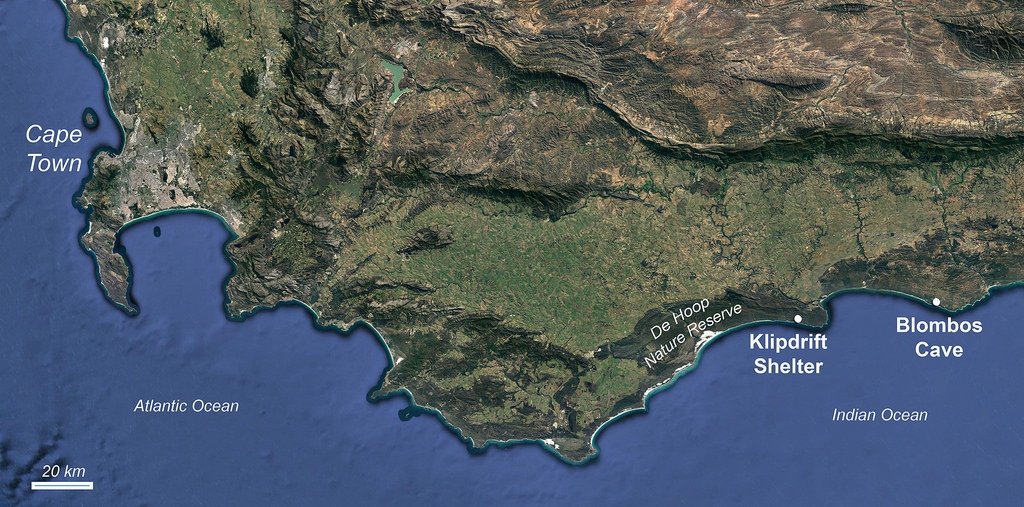
The relative locations of Klipdrift Shelter and Blombos Cave on the southern coast of Africa. Courtesy Chris Henshilwood and the University of the Witwatersrand
___________________________________
Exterior view of the Blombos Cave. Courtesy Chris Henshilwood and the University of the Witwatersrand
______________________________________
Interior panorama of the Blombos Cave. Image credit: Magnus Haaland
__________________________________
What has been your research/investigative strategy related to the work at these sites and your scientific inquiry generally?
I conduct high precision excavations using a range of scientific research methods, such as 3D site plotting, chemical analyses and micromorphology, with all details methodically recorded as we excavate. My research has brought together an inter-disciplinary team of international experts to identify and interpret the various aspects of the sites and artifacts. We then link observations from the different fields and synthesize these with new discoveries, and present these in a global perspective.
In conjunction with rigorous scientific methods, I aim to educate and inspire people – researchers and the general public – about our southern African roots and the prehistory of humanity. The discoveries we have made have changed the way we view our ancestors.
______________________________________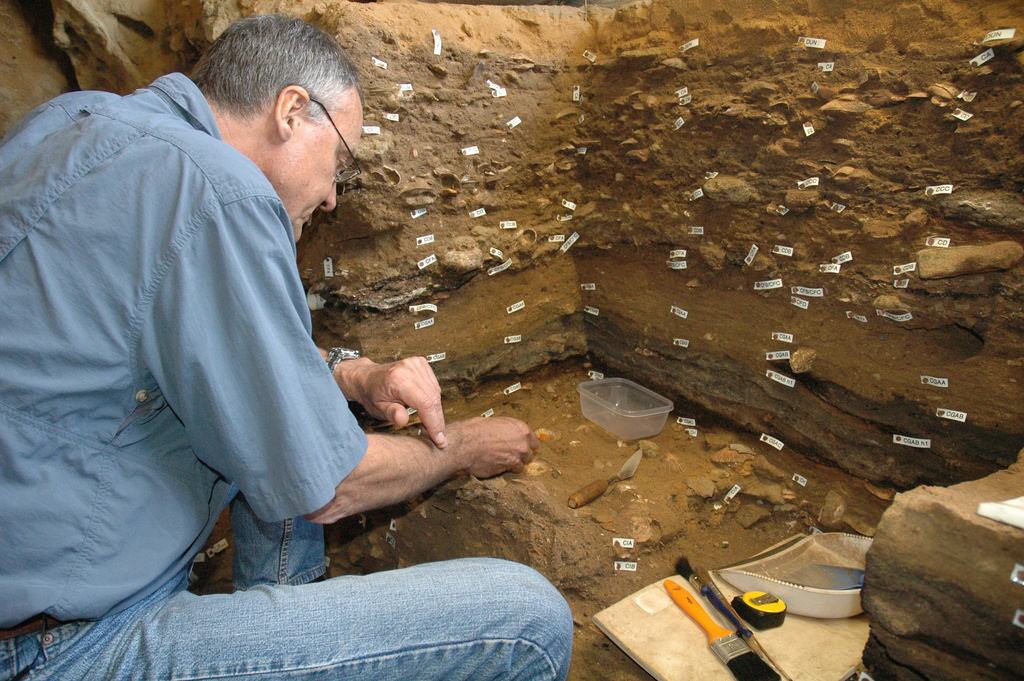
Henshilwood at work within Blombos Cave. Image credit: Magnus Haaland
________________________________________________
What have been the salient finds related to the discoveries you are making bearing on origins of behaviorally modern humans, and why are these finds significant or important?
Blombos Cave and Klipdrift Shelter have yielded an enormous wealth of artifacts that have contributed to our understanding of early [modern] humans and how they evolved. Some of the salient finds are:
- Engraved ochre. Ochre is a form of iron ore and ochre pieces are found at most MSA sites, and are found at Blombos Cave in huge quantities. Many of them were scraped and ground to make flat surfaces and used to create red powder. As early as 100,000 years ago, some of these ground surfaces were then marked with cross-hatches and lines to create complex geometric patterns. It is likely that the designs were made with symbolic intent, but the meaning of these symbols is unknown.
- Engraved ostrich eggshell. We have identified 111 engraved ostrich eggshell fragments from Klipdrift Shelter from layers dating to 65,000 – 59,000 years ago. The designs entail variations of cross-hatched and parallel lines. Diepkloof Shelter, on the western Cape coast, is the only other MSA site in South Africa that has engraved ostrich eggshell, and just 2 pieces were found in the MSA at Apollo 11(site) in Namibia.
- Shell beads. At Blombos, hundreds of Nassarius kraussianus (sea snail or marine tick) shell beads were discovered in sediments dated to 75,000 years ago. All of these shells have holes in them that were made with bone tools, and, based on wear patterns, the shells were then strung together as necklaces or bracelets. The shell beads are among the earliest examples of symbolic objects in the archaeological record. They mark an important step in the emergence of modern social behavior in early humans. Symbols allowed for the transferal of individual and group cultural values, so once symbols were adopted, communication could develop rapidly.
- Ochre-processing toolkits. One of the most remarkable finds we have made at Blombos Cave is an ochre-processing ‘toolkit’, discovered in 100,000-year-old layers. The composite toolkits consist of two Haliotis midae (abalone) shells containing an ochre-rich compound mixture, grindstones, hammerstones, seal bone and charcoal. The toolkits stored an ochre-rich paint mixture, possibly used for decoration on faces, tools or clothes, or perhaps smeared on skin as sun protection. This discovery shows that humans had the conceptual ability to deliberately plan, find, combine and, once produced, store pigmented compounds. This is an important benchmark in the evolution of complex mental processes. People living 100,000 years ago had an elementary knowledge of, what we now call, chemistry.
- Heat treated silcrete and new lithic technologies. Heating silcrete enhances its flaking qualities, allowing for the creation of superior stone artifacts. Pressure-flaked Still Bay bifacial points, on heat-treated silcrete, are found at Blombos Cave in levels dated to 75,000 years ago. Pressure-flaking is a delicate technique that requires skill in sharpening and retouching tools. These points were likely used as spear heads, but may also have had other uses. The presence of these tools shows that the people at Blombos Cave had sophisticated tool-making techniques and were highly innovative in developing new technologies. At Klipdrift Shelter the Howiesons Poort backed tools and blades were also created on heat-treated silcretes. These tools were probably then hafted onto handles to create complex tools. It is likely that the Howiesons Poort marks the period when the first bow and arrow was used with the arrow head composed of small stone segments attached with mastic.
- Bone tools. More than 100 bone tools haven been discovered in the 75,000-year-old layers at Blombos Cave. Some were used as awls to pierce soft material such as hide, while others were polished and possibly hafted and used as projectile points. The systematic manufacture of carefully polished, aesthetically pleasing, bone tools at Blombos Cave suggests that the points may have formed part of a cultural exchange system.
All these items imply enhanced levels of cognitive behavior – behaviors not previously associated with people living in the Middle Stone Age.
______________________________________
Engraved design on ochre nodule from Blombos Cave, c. 75 ka. Courtesy Chris Henshilwood and the University of the Witwatersrand
_____________________________________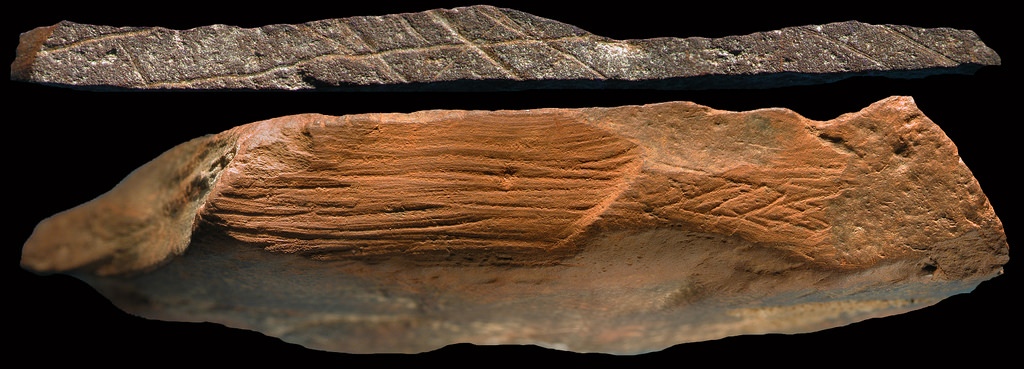
Engraved ochre from Blombos Cave, c. 100ka. Courtesy Chris Henshilwood and the University of the Witwatersrand
________________________________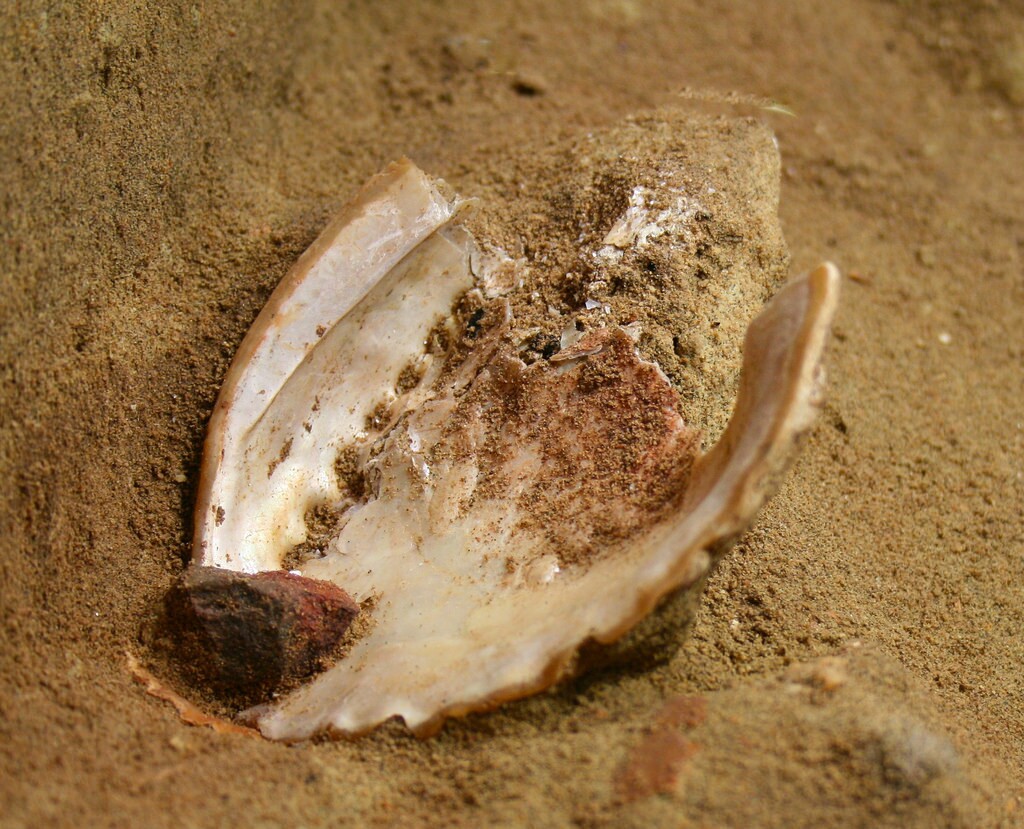
A Haliotis midae shell with ochre residues and an ochre nodule (in situ), which make up part of an ochre processing toolkit from Blombos Cave, c. 100ka. Courtesy Chris Henshilwood and the University of the Witwatersrand
_________________________________
Dr. Karen van Niekerk as she discovered the ochre processing toolkit at Blombos Cave, c. 100ka. Courtesy Chris Henshilwood and the University of the Witwatersrand
______________________________________
Perforated Nassarius kraussianus shell bead from Blombos Cave, c. 75ka. Modern N. kraussianus shells were experimentally strung to determine how the wear on the archaeological shells formed. Courtesy Chris Henshilwood and the University of the Witwatersrand
______________________________________ 
Still Bay bifacial points from Blombos Cave, c. 75ka. Courtesy Chris Henshilwood and the University of the Witwatersrand
Bone tools from Blombos Cave, c. 75ka. Courtesy Chris Henshilwood and the University of the Witwatersrand
_____________________________________________________
If you were to imagine or describe a group of humans who lived during the times relevant to the dating of the finds, how would you define them culturally/behaviorally, if that is possible to any extent?
The people of Blombos Cave and Klipdrift Shelter were anatomically modern humans and they would have looked the same as us today. They were hunter-gatherers who probably lived in extended family groups of 20-30 people that moved fairly extensively across the landscape, possibly with movement dictated by seasonal availability of resources. What we are attempting to discover and what is still the subject of many debates, is whether they were behaviorally the same as us. The use of items, like the shell beads and the engraving of designs, were likely used to signal information to other groups and to cement social relationships – perhaps shared access to resources, or a sense of identity. The ability to do this requires an understanding of abstract concepts and probably included the need for a well-developed language. This is unique to modern humans – and the evidence shows that this was most likely taking place ~100 000 years ago.
How did the landscapes and climate that form the context of the significant finds bearing on behaviorally modern humans differ from how they can be described today?
Climate and environment would have played a major role in where people could live but humans are highly adaptable. Access to resources would have dictated, to an extent, when groups could move around the landscape. Palaeoclimatic data shows that the southern Cape was a lush Mediterranean environment with an abundance of resources. Conditions also suggest that there was a lack of disease such as bilharzia, malaria, and tsetse-fly (Trypanosomiasis).
Glacial and interglacial periods in the last 100,000 years drastically modified conditions and sea levels, and affected what resources were available. For example, we know from looking at marine sediment and ice cores that ~76,000 years ago global temperatures dropped, polar ice sheets grew and sea levels dropped. Conditions changed from being warm and rainy to colder and drier. This coincides with the sudden disappearance of the bifacial point culture, known as the Still Bay culture, and the later appearance of a new culture – the Howiesons Poort. When this climatic change occurred it’s likely that the Still Bay people moved, following the sea as the continental shelf became a highly productive plain.
Climatic changes affected the kinds of tools and technologies used, as well as communicative strategies that were necessary. Climate change may have been one factor responsible for the migration of some small groups of Middle Stone Age people out of Africa. However, people may also have moved because of their advanced cognition and technologies, thus resulting in easier access to a greater range of resources, such as smaller animals and marine life through hunting, snaring and fishing. A knock-off effect of this would have been expanded social structures and, in time, increased population sizes.
What are your plans for the future related to this topic and what do you hope to accomplish?
We will continue excavations at Klipdrift Complex as well as continue our analysis of the wealth of material from Klipdrift Shelter and Blombos Cave. Together with my students, post docs and other experts, for example in social psychology, climate reconstruction, dating and micromorphology, we will continue to produce inter-disciplinary scientific research and push the boundaries of science to better understand our early [modern] human ancestors.
A current priority is to test the hypothesis that many of the cultural developments of early Homo sapiens are related to climate variability. Currently much research is being done on reconstructing climate and vegetation changes in Europe and in southern Africa, and on comparing the ecological niches exploited by human groups during climatic phases. Climate may have been a major factor in early Homo sapiens development, possibly even defining who we were and what we have become.
We are currently constructing a new learning centre and museum in the Hoop Nature Reserve, just a few kilometers from the Klipdrift Complex. This will be called the De Hoop Human Origins Centre. The primary mission of the centre is to display, explain and interpret the origins of our own species, Homo sapiens, whose origins lie in Africa. A core aim is to show how people from all nations, creeds and colors share one origin and common ancestors. Armed with this knowledge we can still celebrate our cultural diversity and current identities but the centre will help break down present conceived boundaries based on culture, religion and race and install a new sense of pride in all our visitors as we celebrate the common African origin of us all. The centre will be developed and managed as a community resource to inspire, educate and inform the community and visitors and to contribute to the conservation of the history, prehistory and heritage of the southern Cape, southern Africa and Africa.
On a more personal level, how did you arrive at your present point in time (related to your research), and what inspired you to ‘journey’ on this course in your life?
In 1961, my grandfather bought the property that Blombos Cave is on, and I spent many holidays there, often searching the hills and caves for artifacts. In 1985 I enrolled for a degree in archaeology at the University of Cape Town and went on to do my PhD in Archaeology at Cambridge. I returned to Blombos in 1991, as a PhD student, to search for Later Stone Age sites and artefacts in the area. During this search I discovered Blombos Cave and after excavating 50 cm of Later Stone age material I uncovered the top layers of the MSA levels. Bifacial points and bone tools lay on the surface. This was the start of the adventure and after numerous unsuccessful attempts at raising funds I was eventually rewarded with a generous 3-year National Science Foundation grant at Stony Brook University in New York and also support from National Geographic. This was the start of the adventure.
Are there any other comments or statements you would like to make about the topic?
Despite significant advances in recent years, it must also be emphasized that well-dated archeological sites between c. 300 ka and 100 ka are rare, so the evolution of Homo sapiens and the earliest emergence of symbolic behavior during this key period is still poorly understood. There might have been a sudden surge in human innovation at c. 100 ka, but the possibility of a much longer and gradual evolution of modern symbolic behavior following a mosaic pattern is clearly probable.
Another possibility is that, despite the appearance of anatomically modern humans at c. 300 – 200 ka, neural reorganization within the human brain was not a punctuated event, but happened gradually between 300 – 200 ka and 100 ka. Depending on selective criteria that may have favored or disfavored novelty and change, periods of rapid innovation or stasis might have followed. Until a clearer picture of human evolution between 300 ka and 100 ka has emerged, it is hard to produce a detailed argument about the earliest links between neural and behavioral evolution in early Homo sapiens but it seems plausible that the building blocks for social systems mediated by symbolic behavior were laid during this time.
The origins of ‘modern’ human behavior generates lively debate world-wide, but the African evidence for its origins has long remained elusive. Published results from the Blombos Cave excavations complement recent and older findings from a number of African MSA sites that suggest some aspects of ‘modern behavior’ evolved during the early Late Pleistocene in Africa. The discoveries at Blombos Cave clearly reflect the acquisition of fully modern cognitive abilities by southern African populations by at least 100,000 years.
____________________________________
Chris Henshilwood at Blombos Cave. Courtesy Chris Henshilwood and the University of the Witwatersrand
____________________________________
Read more about this topic in the article, Where Hominins Became Human, a free premium article published in the Fall 2016 issue of Popular Archaeology.
____________________________________

